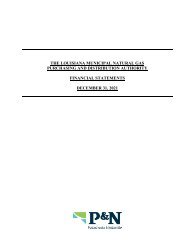GOHSEP Elected_Officials_Manual_2015
Create successful ePaper yourself
Turn your PDF publications into a flip-book with our unique Google optimized e-Paper software.
<strong>GOHSEP</strong><br />
Louisiana <strong>Elected</strong> <strong>Officials</strong><br />
Emergency Management <strong>Manual</strong><br />
Prepare + Prevent + Respond + Recover + mitigate<br />
6.1 Local Hazard Mitigation Plan (HMP)<br />
It is important to understand how hazard mitigation relates to emergency management. In<br />
the early 1980s, Federal Emergency Management Agency (FEMA) was charged with developing<br />
a structure for how Federal, State and local governments respond to disasters. FEMA identified<br />
the phases of emergency management. Hazard mitigation initiatives disrupt the cycle of<br />
disaster, damages, repair, another disaster, damages, repair . . .<br />
Hazard Mitigation is described by FEMA and the Disaster<br />
Mitigation Act of 2000 (DMA 2000) as any sustained<br />
action taken to reduce or eliminate long-term risk to<br />
life and property from a hazard event. Section 322 of the<br />
Robert T. Stafford Disaster Relief and Emergency Assistance<br />
Act (Stafford Act), as amended by DMA 2000, provides for<br />
States, Federally recognized Native American Tribes and<br />
local governments to undertake a risk-based approach<br />
to reducing risks to natural hazards through mitigation<br />
planning.<br />
Mitigate<br />
Recover<br />
Prepare/Prevent<br />
Respond<br />
Event<br />
FEMA published an Interim Final Rule that sets forth the guidance and regulations under which DMA<br />
2000-compliant State Hazard Mitigation Plans (SHMPs) are to be developed. This Interim Final Rule<br />
provides detailed descriptions of the planning process that States and localities are required to observe.<br />
Hazard mitigation reduces vulnerability so that<br />
communities are better protected from the impacts of a<br />
disaster and are able to recover more quickly should a<br />
disaster occur. Local mitigation plans are important.<br />
They represent the jurisdiction’s commitment to an allhazards<br />
approach to reduce risks from hazards and serve<br />
as a guide for decision makers as they allocate resources<br />
to reduce the effects of natural hazards. The SHMP serves as<br />
a strategy for the implementation of mitigation activities in<br />
Louisiana.<br />
A Hazard Mitigation Plan . . .<br />
q Articulates the Planning Process.<br />
q Includes a Risk Assessment.<br />
q Identifies Mitigation Strategies.<br />
q Provides for Plan Maintenance.<br />
q Requires Plan Adoption.<br />
6.1 Local HMP Page 1 of 3<br />
Revised: December 21, 2014

















